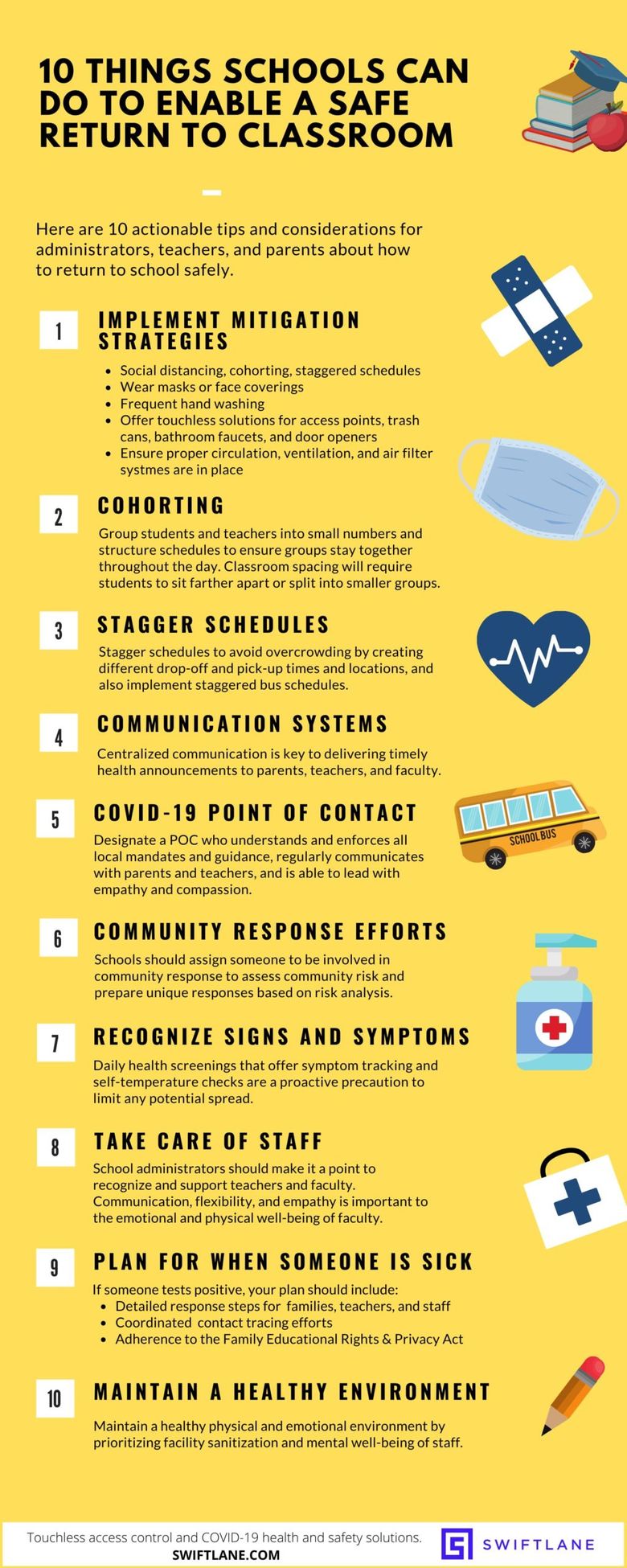The usual “back to school” hype looks a lot different this year with COVID-19 creating uncertainty around safety and security for teachers and students. School officials and administrators are tasked with figuring out how — and if — they can safely bring students and teachers back into a physical classroom.
Although according to the CDC, “no other setting has more influence on a child’s health and well-being than their school” aside from their home, many parents fear for the safety of their children and are anxious about the plan to keep them safe. With summer quickly winding down, administrators, teachers, and parents are still struggling to find the answers to these important questions:
- What are the new cleaning protocols?
- Will testing and health screening be implemented?
- Will capacity and classroom size be smaller?
- What will online learning look like?
Check out the infographic below for the answers to these questions and more guidance around the 10 things schools can do to enable a safe return to the classroom this fall.
1. Implement Mitigation Strategies
The coronavirus is mostly spread from person-to-person through respiratory droplets from a sneeze, cough, or when talking. To increase safety and decrease the virus spread, it’s critical to have preventative measures in place that include:
- Social distancing (keeping 6 feet apart)
- Wear masks or face coverings
- Frequent hand washing
- Implement cohorting and staggered schedules
- Offer touchless solutions for access points, trash cans, bathroom faucets, and door openers
2. Cohorting
Cohorting means grouping students and teachers together in smaller numbers. These groups stay together during the entire day. By doing this, it limits the number of people that students and teachers have contact with which:
- Decreases opportunities of potential exposure to COVID-19 or any other communicable disease
- Reduces the contact of shared surfaces
- In the event of a positive case, makes contact tracing and targeted testing easier
3. Stagger Schedules
Scheduling is key to ensure social distancing and avoid overcrowding. In schools, this often happens when students are dropped off and picked up, so schools can:
- Stagger drop off and pick up times for students
- Coordinate different drop-off locations
4. Communication Systems
Communication is key when so many different players are involved. Families and staff need to be updated when issues, news, and announcements arise. This is especially important when it comes to operational changes. A communication system via email or mobile app offers the following benefits:
- Creates an easily accessible communication system for parents
- Makes sure important points of contact are posted and notified if need be
- Ensures everyone knows how to report signs, symptoms, positive test results
5. Designate COVID-19 Point of Contact
Every school needs to have one person that is assigned to dealing with COVID-19 concerns. This person should:
- Have a good grasp of COVID-19 concerns not only within the school but also within the community
- Be up to date on all local mandates and guidance
- Be prepared to communicate updates to parents and students
- Be highly accessible and known to all
- Be empathetic and compassionate
6. Participate in Community Response Efforts
Schools are a major player in any community. It would be helpful to have someone from the school involved in the community response to:
- Assess specific community risk
- Prepare a unique response based on that risk
7. Recognize Signs and Symptoms
Parents and caregivers should be aware of signs and symptoms of COVID-19. Stopping sickness before it reaches the school will keep everyone safe. Daily health checks are a proactive precaution to limit any potential spread.
- Health checks that screen for symptoms of the virus should be done daily
- Students with any of those symptoms should stay home from school
- Use digital health screening tools for a safe way to track symptoms
8. Take Care of Staff
Empathy is oftentimes overlooked when dealing with any crisis. School administrators should make it a point to recognize and support teachers and faculty. Communication, flexibility, and empathy is important to the emotional and physical well-being of faculty.
- Prepare for the need of additional staff
- Cross-train staff to perform more than just their typical function
- Create a roster of trained and reliable back-up staff
- Review and revise employee leave and compensation policy
- Consider remote work for staff who need it, especially those needing childcare
- Create a flexible sick leave policy to encourage staff to stay home when they are sick, have been exposed, or are caring for someone who is sick
9. Plan and Prepare for When Someone Is Sick
If someone tests positive, a unique response plan should be in place. This should be based off school needs and rate of community transmission. Developing a plan based on the CDC issued guidance is critical to stopping spread. This plan should:
- Include detailed response steps and be available to families and school staff
- Coordinate with state and local health authorities to conduct contact tracing
- If a student tests positive, adhere to the Family Educational Rights and Privacy Act (FERPA). The Department of Education issued an FAQ on navigating FERPA and the coronavirus.
- Communicate a positive case to families and staff
- Be handled with sensitivity
10. Maintain a Healthy Environment
Facilities
It is important to maintain a clean and hygienic school environment. Regular cleaning and sanitizing of high-touch areas should be scheduled throughout the day. Frequency of disinfection should be increased as activity increases. EPA-approved disinfectant should be adopted and used.
Mental Health
COVID-19 has caused a great amount of stress and anxiety. When returning to the classroom, it’s important to stress healthy mental wellness. Make sure students, parents and teachers know about services the school has to offer to support mental wellbeing and encourage open and honest conversation. Coping with stress can be managed, and schools are a great place to find support and community.
More Resources
CDC Cleaning and Disinfecting Guidelines
CDC Social Distancing Guidance
Daily Home Screening for Students
Implement a Safe Return to School
Contact us to learn more about Swiftlane Health Check COVID-19 safety tools and resources.






